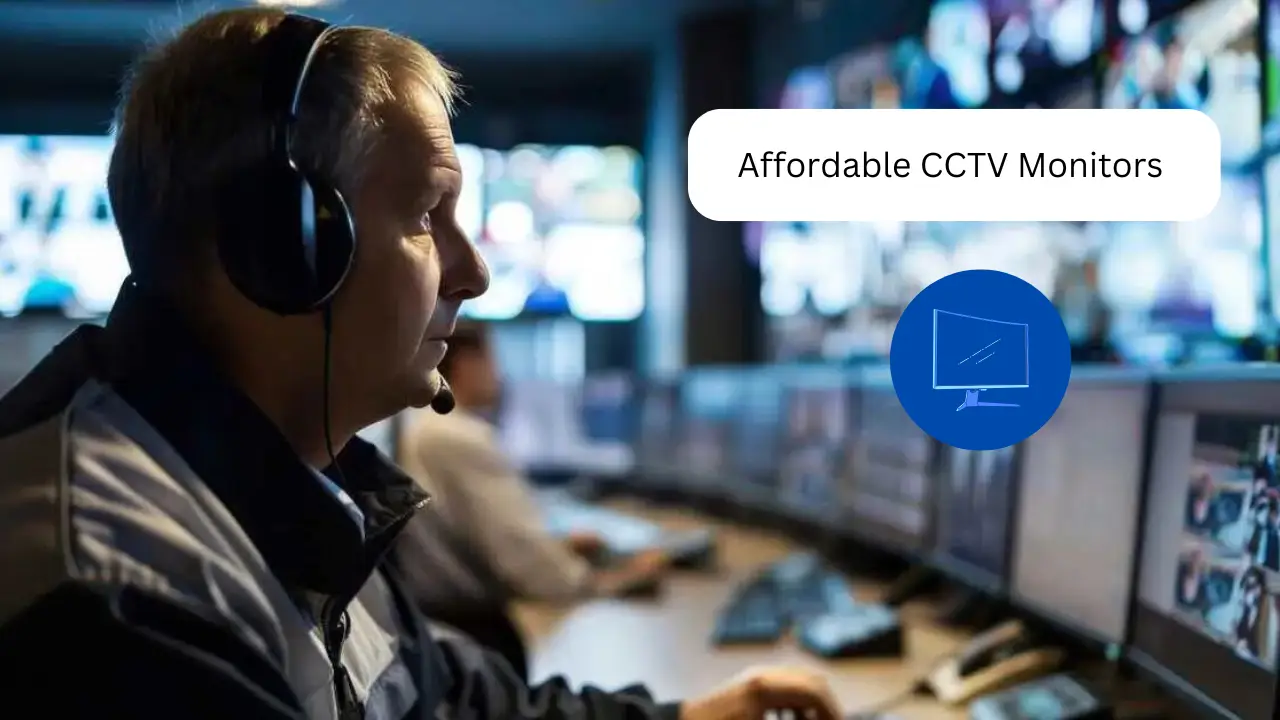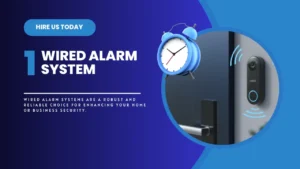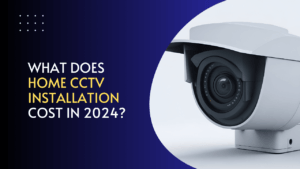Security surveillance systems require reliable CCTV monitors to display clear, real-time footage from security cameras. Many businesses and homeowners need quality CCTV monitors but face budget constraints when selecting appropriate display solutions. The market offers numerous affordable options that deliver essential monitoring capabilities without compromising fundamental features.
These specialized CCTV monitors come in various sizes and specifications to suit different security needs. The article examines budget-friendly options across popular screen sizes, from 19-inch displays to larger 27-inch models. Readers will learn about key features, connectivity options, and practical tips for selecting the right CCTV monitor that balances cost with performance.
Understanding CCTV Monitors
Specialized CCTV monitors serve as the cornerstone of effective surveillance systems, designed specifically for continuous security monitoring operations. Unlike standard computer displays, these purpose-built screens are engineered to handle the demanding requirements of security installations.
What are CCTV monitors?
A CCTV monitor is a display device explicitly designed for continuous video surveillance operations. These monitors utilize LED or LCD technology optimized for extended operation periods, typically running 24/7 without suffering from screen burn-in or degradation. They support various input connections, including BNC, VGA, and HDMI, making them compatible with different security camera systems.
Key features to look for
When selecting a CCTV monitor, several critical features deserve attention:
- Display Resolution: Supports common security resolutions from 720p to 4K
- Input Compatibility: Multiple connection options for different camera systems
- Screen Size: Available in ranges from 19 to 32 inches
- Durability: Rugged construction for continuous operation
- Energy Efficiency: LED technology for reduced power consumption
- Image Processing: Enhanced capabilities for low-light conditions
Benefits of specialized CCTV screens
Specialized CCTV monitors offer distinct advantages that make them superior to regular displays for surveillance applications. Their robust construction ensures reliability in harsh environments, with sealed casings protecting internal components from dust and moisture. These monitors are engineered for optimal performance in security settings, featuring faster response times and specialized image processing for security footage.
Modern CCTV monitors’ energy efficiency translates to significant cost savings over time, especially in 24/7 surveillance operations. Their specialized design includes built-in speakers and multiple input ports tailored specifically for security camera systems, eliminating the need for additional equipment.
These monitors typically maintain a 4:3 aspect ratio, which is ideal for security camera feeds and ensures compatibility with most surveillance systems. The professional-grade components used in their construction contribute to extended lifespans, often outlasting standard computer monitors in continuous operation scenarios.
For multi-camera setups, CCTV monitors offer seamless integration with security systems, providing clear, detailed images without the lag or refresh rate issues common in consumer displays. Their specialized image processing capabilities enhance video feeds from security cameras, particularly in challenging lighting conditions or when monitoring multiple camera feeds simultaneously.
Top Budget-Friendly CCTV Monitor Options
The market offers numerous budget-friendly CCTV monitors that deliver reliable performance without breaking the bank. Manufacturers have developed cost-effective solutions for various surveillance needs, from compact screens to larger displays.
19-22 inch monitors
Several affordable options provide excellent value in the compact monitor category. The M.C Vision 19″ LED monitor, priced at £74.99, offers Full HD 1080P resolution with multiple connectivity options, including BNC, HDMI, and VGA inputs. These smaller monitors are ideal for space-constrained environments and typically consume less power.
For those seeking dual-monitor setups, matched pairs of 19-inch displays with height-adjustable stands are available starting at £59.99. These bundles often include necessary cables and mounting hardware, making them a cost-effective solution for multi-camera monitoring.
23-27 inch monitors
Mid-sized monitors offer an optimal balance between screen real estate and affordability. The market features several LED-backlit displays in this range, with prices typically ranging from £69.99 to £149.95. These monitors commonly include:
- Multiple input options (HDMI, DVI, VGA)
- Built-in speakers for audio monitoring
- Energy-efficient LED panels
- Response times as fast as 1ms
4K resolution options
The emergence of affordable 4K CCTV monitors has revolutionized surveillance capabilities. The SPRO 28″ LED monitor represents an excellent value proposition in this category, featuring:
For larger installations, the Hikvision DS-D5043UC 42.5″ monitor offers professional-grade features at a competitive price point. This model delivers superior image clarity with 4K resolution at a 60Hz refresh rate, making it particularly effective when paired with 4K security cameras.
These 4K monitors provide enhanced detail visibility, crucial for identifying subtle details in surveillance footage. The higher resolution proves especially valuable when monitoring large areas or when precise identification is required. Modern 4K options include advanced features like D-LED direct-lit screens and multiple interface options, ensuring compatibility with various security system configurations.
The latest generation of budget-friendly 4K monitors also incorporates energy-efficient technology, helping to offset the initial investment through reduced operating costs. Many models feature narrow bezels for minimal visual interruption in multi-monitor setups, and their industrial-grade construction ensures reliable performance in 24/7 operation scenarios.
Factors to Consider When Choosing
Selecting the right CCTV monitor requires careful consideration of several technical and practical factors that directly impact surveillance effectiveness. Understanding these key elements helps make an informed decision aligning with specific monitoring requirements.
Resolution and image quality
The foundation of effective surveillance lies in crystal-clear image quality. Modern CCTV monitors support resolutions ranging from 1080p (Full HD) to 4K (Ultra HD), with some advanced models even offering 8K capabilities. The optimal resolution depends on specific surveillance needs:
Image quality extends beyond resolution, encompassing factors like contrast ratio (ideally 10000:1) and brightness levels (minimum 300 Cd/m2) for optimal visibility in various lighting conditions.
Connectivity options
Modern CCTV monitors must offer versatile connectivity to ensure seamless integration with existing security infrastructure. Essential connection types include:
- Multiple BNC inputs/outputs for analog systems
- HDMI ports for digital high-definition signals
- VGA connections for legacy equipment compatibility
- Audio inputs/outputs for sound monitoring capabilities
The availability of multiple connection types ensures future-proof compatibility and easy system upgrades without requiring complete hardware replacement.
Durability and longevity
Professional CCTV monitors are engineered for continuous operation in demanding environments. Key durability factors include:
Operating temperature tolerance between 0 to 50°C ensures reliable performance across various environmental conditions. The monitor’s construction should maintain functionality within 20% to 70% humidity, protecting internal components from moisture damage.
Response time is crucial for surveillance applications, with professional monitors offering speeds between 5-8ms to capture swift movements without motion blur. The viewing angle (typically 170°/160°) ensures clear visibility from multiple positions in the monitoring room.
Energy efficiency
LED technology has revolutionized CCTV monitor efficiency, offering significant advantages over traditional LCD displays. Modern LED monitors consume approximately 40% less power than their LCD counterparts, resulting in substantial cost savings for 24/7 operations.
Power consumption metrics vary by screen size:
- 19-inch models typically consume 20 watts
- Larger displays may require up to 35 watts
- Smart power management features can further reduce consumption during low-activity periods
The combination of LED technology and intelligent power management reduces operational costs and extends the monitor’s lifespan through reduced heat generation and component stress. This efficiency becomes particularly significant in multi-monitor setups, where cumulative power savings can be substantial.
Professional CCTV monitors incorporate specialized features like automatic brightness adjustment and screen timeout options, further optimizing energy usage while maintaining surveillance effectiveness. These energy-efficient designs lower total ownership costs while supporting environmental sustainability goals.
Installation and Setup Tips
Proper installation and setup of CCTV monitors are crucial in maximizing surveillance system effectiveness. A well-planned setup ensures optimal viewing angles, reliable connectivity, and superior image quality for security monitoring operations.
Proper placement
The positioning of CCTV monitors requires careful consideration of both ergonomic and technical factors. The optimal installation height typically ranges between 2.5 to 5 meters, depending on the monitoring environment. For control room setups, monitors should be positioned at eye level when operators are seated, approximately 100-120 cm from the floor.
Key placement considerations include:
- Adequate viewing distance based on screen size
- Protection from direct sunlight to prevent glare
- Proper ventilation for heat dissipation
- Accessibility for maintenance and cleaning
Lighting conditions significantly impact monitor visibility. Control rooms should maintain consistent, moderate lighting to reduce eye strain and enhance image clarity. The recommended ambient light level ranges between 300-500 lux for optimal viewing conditions.
Connecting to your CCTV system
Establishing reliable connections between cameras and monitors requires proper cable management and compatible hardware. A typical setup involves:
For multi-monitor configurations, implementing a video distribution system ensures consistent signal quality across all displays. Modern CCTV monitors support various input options, including:
- Direct camera connections via BNC cables
- Network-based connections through NVRs
- Hybrid setups combining analog and digital signals
Cable management becomes particularly important in professional installations. Proper routing and protection of cables not only enhance system reliability but also contribute to a cleaner, more organized monitoring environment.
Optimizing display settings
Proper configuration of display settings ensures optimal image quality and system performance. The initial setup should focus on:
Resolution Configuration:
- Match native resolution of cameras
- Enable proper aspect ratio settings
- Adjust refresh rates for smooth motion
Color calibration plays a vital role in accurate surveillance monitoring. Professional CCTV monitors require specific adjustments:
- Brightness: Set between 200-300 cd/m² for indoor environments
- Contrast: Maintain 1000:1 ratio for clear image definition
- Color temperature: Standard 6500K for accurate color reproduction
- Gamma: Configure to 2.2 for optimal detail visibility
For installations involving multiple monitors, synchronization of display settings ensures consistent image quality across all screens. Modern CCTV monitors often include preset modes specifically designed for surveillance applications, which can serve as excellent starting points for fine-tuning.
The implementation of power management features helps extend monitor lifespan while maintaining operational efficiency. Setting appropriate sleep modes and screen timeout intervals can significantly reduce power consumption during low-activity periods.
System integrators should consider implementing regular maintenance schedules for:
- Display calibration checks
- Connection integrity verification
- Firmware updates when available
- Physical cleaning of screens and ventilation areas
Professional CCTV monitors often include advanced features that require proper configuration for optimal performance. These may include:
- Motion-adaptive processing
- Dynamic contrast enhancement
- Anti-burn-in technology
- Multi-screen layout options
For control room environments, establishing standardized configuration protocols ensures consistent performance across all monitoring stations. This includes documenting optimal settings for different surveillance scenarios and maintaining calibration records for quality assurance purposes.
Conclusion
Affordable CCTV monitors prove that effective surveillance solutions need not strain financial resources. Modern budget-friendly options deliver professional-grade features, including high resolution displays, multiple connectivity options, and robust construction for continuous operation. These cost-effective solutions maintain essential monitoring capabilities while offering the durability and reliability required for security applications, making quality surveillance accessible to businesses and homeowners alike.
Successful CCTV monitoring implementation depends on carefully considering technical requirements and proper setup procedures. Smart selection based on specific monitoring needs and appropriate installation and optimization ensures maximum value from these budget-conscious investments. The wide range of available options, coupled with advancing display technology, enables security-conscious users to build capable monitoring systems that balance performance with cost-effectiveness.
## FAQs
What type of monitor is required for a CCTV system?
To ensure optimal display of your CCTV footage, match your monitor’s resolution with your camera’s. For instance, a 4K security camera should be paired with a monitor capable of displaying 4K resolution to utilize the camera’s high-resolution capabilities fully.
Can a television be used as a monitor for CCTV?
Yes, a TV can be a CCTV monitor if you use a BNC to HDMI converter. This setup is suitable for HD security cameras such as AHD, HD-TVI, and HD-CVI, ranging from 720p to 4K resolution.
Is it possible to operate a CCTV system without a monitor?
Yes, CCTV systems can function without a monitor. These systems typically record footage automatically, allowing for later review without the need for real-time monitoring.
How can I view CCTV footage on a TV without using a DVR?
To view CCTV footage on a TV without a DVR, follow these steps: Connect the CCTV camera to a VCR using an RCA cable, power the camera with a suitable adapter, link the VCR to your TV with another RCA cable, and set the TV and VCR to channel 3 or 4 for live viewing.
What are some CCTV camera options that avoid proprietary software?
For those seeking CCTV cameras that do not require proprietary software, consider options that support open protocols and can be integrated with open-source software for functions like motion alerts and recording. Brands vary, and some may require firmware adjustments to avoid default software limiting local network use.




